A guide to the season
The Spring Almanac
With the arrival of spring comes a refreshed optimism, an excitement for warm weather adventures and a hunger to jump into something new. In our inaugural seasonal almanac, we share what we’ll be wearing, reading, eating and listening to through the coming months.
A nine-minute read.

The seasonal menu with Chef Isobel Little
The months ahead will see the perennial return of some of the nation’s most vibrant and exciting produce. Showcasing just how to make these spring ingredients sing is Swillhouse Head Chef Isobel Little, who is currently overseeing the team at Sydney-side favourite Huberts, as well as preparing for the launch of an exciting new venue, Caterpillar Club, set to open this October.
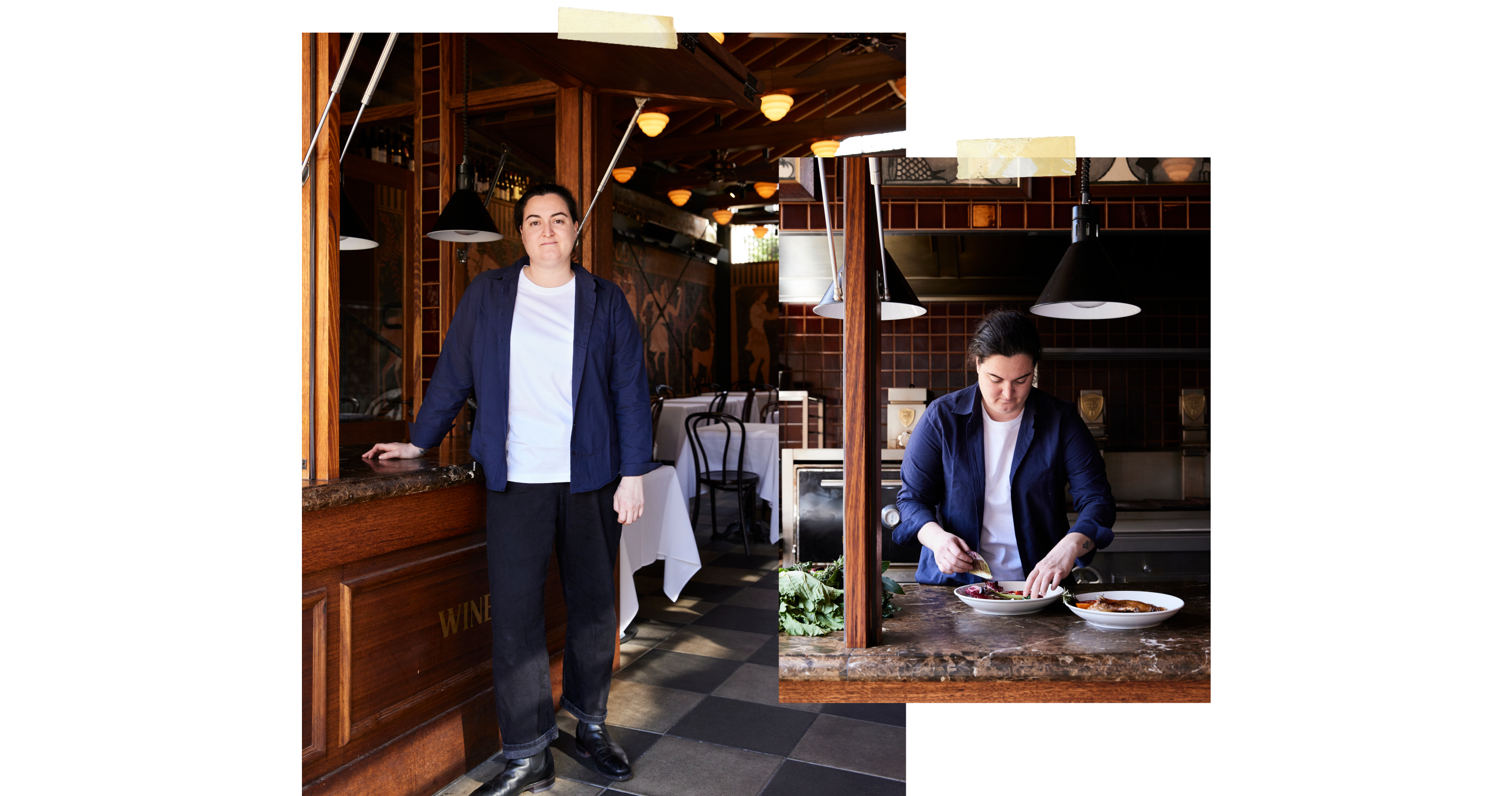
“I’ve been working with Swillhouse for around 6 months now - I like the challenge of opening new establishments and I’m hoping my experience from London, Europe and everywhere in between will help shape the opening of Caterpillar Club.”
The venue’s UK-inspired menu – “think seafood pies, tongue and cheek skewers and steamed puddings” – is a far cry from the food Isobel grew up eating in Gloucester, a rural town in New South Wales. Her parents would trade their homegrown flowers and chickens for other produce with other locals, often resulting in dinners of roast duck – a dish that Isobel has refreshed for our new spring menu.
In the two recipes below – both exclusive to R.M.Williams - you’ll find a hearty spring meal to share with friends and loved ones, with in-season produce centre stage. Isobel’s commitment to cooking with seasonal, local ingredients is an admirable directive for home cooking throughout the year, as is her desire to create food that brings people together. “I started washing dishes in a local café when I was very young and I fell in love with hospitality – specifically, how it brings people together to break bread, with friends and strangers alike.”
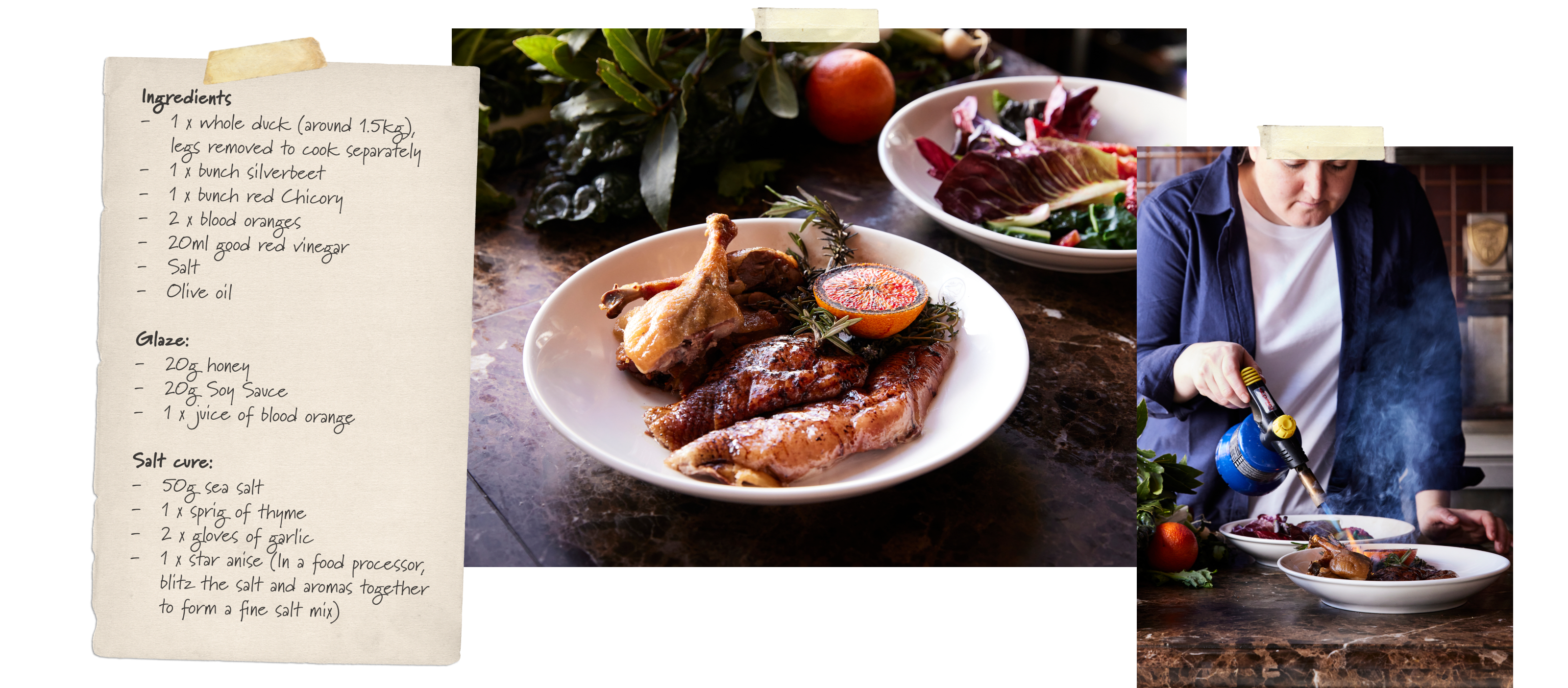
Roasted Duck with Native Blood Orange and Bitter Greens
My style of cooking is minimal interference, so the produce can shine. This recipe is a great example if using just a handful of ingredients to showcase some amazing local food.
If you can, get your hands on a Maremma duck from Tartha Place - they focus on a great Regenerative Practice (species cycle of rotation and rest to break pathogen cycles and sequester soil carbon) and all of their animals are happy and healthy. You can source them from Emilio's Butcher in Rozelle, an incredible Sydney-based independent butcher who source whole animals directly from small local producers who focus on pasture, free-range and ethical produce. Ask your butcher (or Will, if you go to Emilio's) to remove the legs for you - removing the legs allows you to get a much more even cook on the breast, and cooking on the bone ensures a much more flavourful end result (as well as then being a beautiful table piece when served!)
If you choose to remove the legs yourself: cut down between the leg and the body with a very sharp knife, then pop the leg joint (you will actually hear a pop) by cutting through the joint - separating the leg from the body. Repeat on the other side.
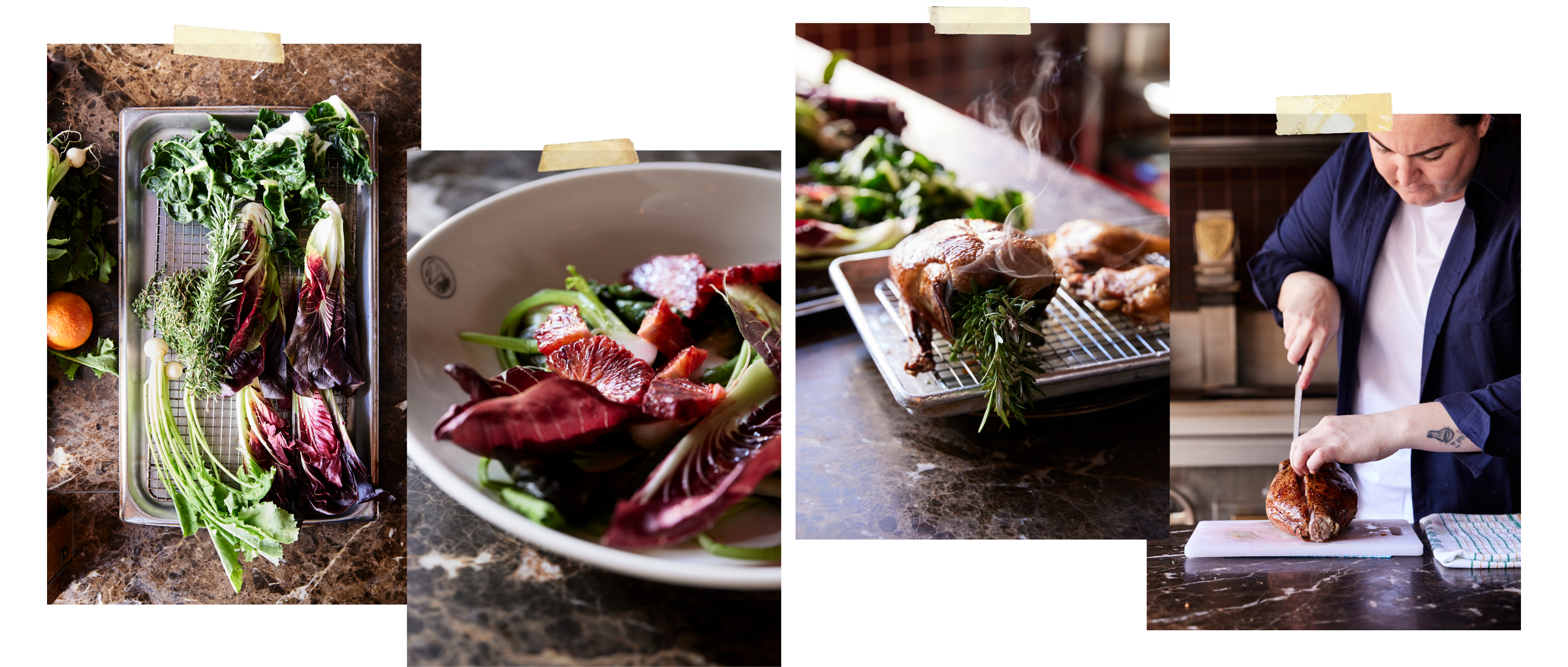
Method:
To prepare, cover the duck legs with the salt mixture and leave in the fridge for around 6 hours. When ready, wash off the salt cure and gently pat dry.
Place into a baking tray and cover with vegetable oil, or duck fat (you can buy duck fat from your local butchers), then cook the duck legs for around 3 hours at 120°C and allow them to cool in the fat. Please do this the day before, or a couple of days before you intend on roasting the crown.
To cook the crown:
- Set oven to 200°C and allow the duck to come to room temperature from the fridge before cooking. Rub with olive and salt (apply liberally). At this time, remove the already cooked duck legs from their container and place onto a separate tray with baking paper, skin side up.
- Place the duck on a roasting rack within a baking tray and add a small amount of water to the tray (this will catch all the fat and stop the oven smoking up). Usually it takes around 30-40 minutes to roast a crown of duck to a medium rare; during 10 minute intervals brush down the duck with the glaze, this will help achieve an even colouring throughout the cooking process. Rotate the duck if necessary and inspect the duck for doneness by checking the widest part of the breast. Once the crown is cooked remove the duck and set aside to rest for 10 minutes.
- While the duck is cooking, quarter the red chicory, prepare the greens and peel and slice the blood orange. Add water and a pinch of salt to a large saucepan and set over a high heat to bring to a boil. Set another frying pan over a high heat.
- While the duck is resting, take the pre-cooked legs skin side up and place them in the oven - this will re-heat them and allow the skin to crisp. Remove them when the skin is golden brown and crispy.
- Nestle the quartered chicory into the hot frying pan, colouring on all sides, before adding the vinegar and placing into the oven. Blanch your greens in the boiling water then toss with some salt and pepper.
- Carve on either side of the breastbone and remove the duck breasts, then slice the duck breast into 1/2inch pieces. Season the flesh well with salt, and serve the sliced duck and crispy duck legs with pan juices, over the top of the roasted greens with blood orange to garnish.
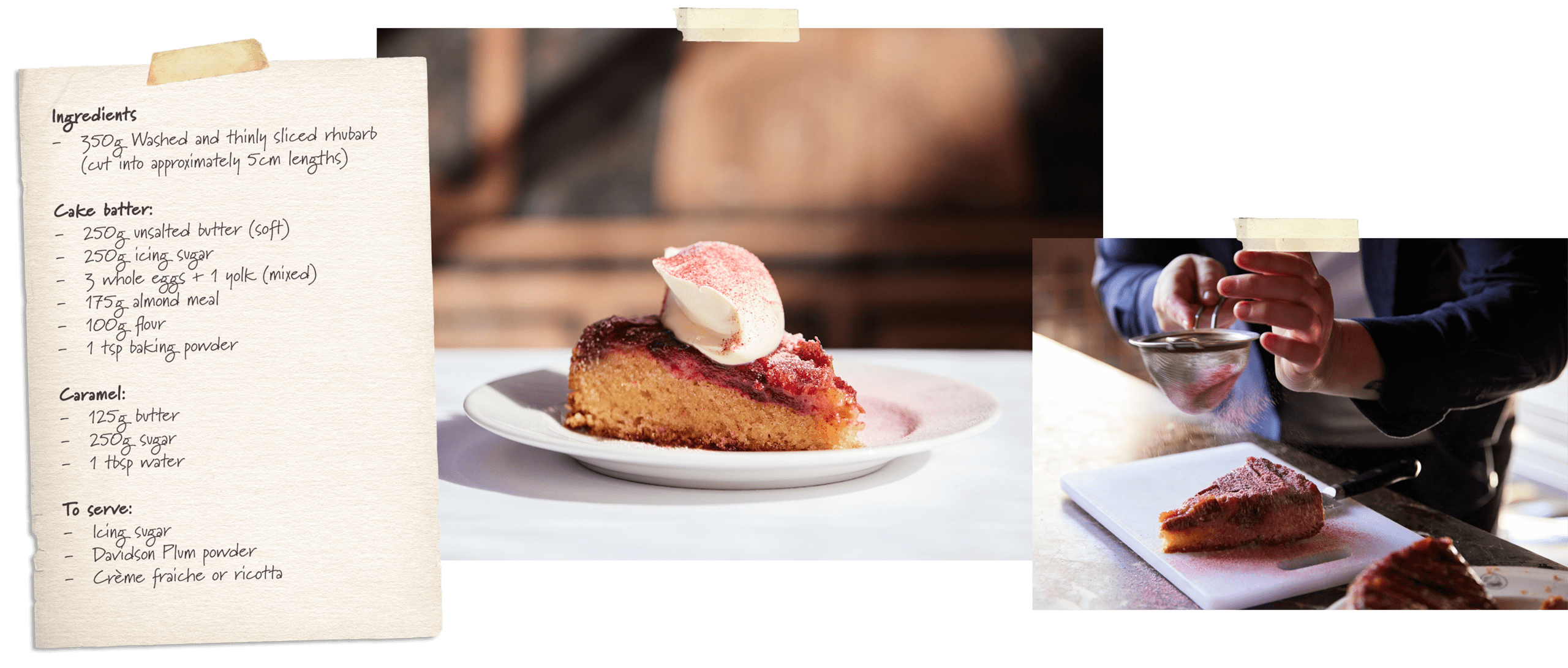
Rhubarb and Davidson Plum Cake
Tangy and sweet with a juicy texture, rhubarb is one of my favourite things to include in a desert. In this recipe I've paired it with Davidson Plums, but in general this cake batter really lends itself both to stone fruits and citrus - it has both sweet and salty notes and a delicious chewiness from its caramel layer. The added beauty in this recipe being so adaptable, is that you can substitute in fruit according to what's in season; I would recommend going to your local farmer’s market to see what’s on offer.
*Chef's note, if you're not feeling confident enough to do the caramel layer, feel free to omit, as the cake will be delicious without too.
Method
To prepare, line a 25cm cake tin with parchment paper and pre heat your oven to 160°C.
To make the caramel:
- Combine the sugar, butter and water in a heavy based saucepan, and whisk quickly whilst the mixture comes to a simmer (brush down the sides of the saucepan if needed).
- Once the caramel has become a medium brown colour, pour quickly into the cake tin, taking care not to spill as the caramel will be incredibly hot. Move the cake tin around (carefully) once the mixture is in, in order to quickly spread the caramel for an even layer on the cake. Please note, the caramel will set relatively quickly.
- Arrange the sliced rhubarb on top of the caramel, creating an even layer. It is best to lay the rhubarb pieces in the same direction, side by side and covering the bottom of the cake tin well.
To make the cake:
- Whisk the butter and sugar until combined (this will take around 5-8 minutes in an electric mixer with a whisk attachment). Once fluffy, slowly add the combined eggs, and then finally, fold through the dry ingredients with a spatula, and add a pinch of salt.
- Pour the batter into the cake tin, covering the rhubarb. Bake for approximately 50 minutes to an hour, or until a cake tester (or clean knife) comes out clean when inserted into the middle of the cake.
- Allow cake to cool slightly, then flip it over gently onto a plate. Once flipped, remove the tin and gently peel off the baking paper from the caramel top. Serve warm, with a dollop of crème fraiche or ricotta.

Australian storytelling to inspire
As we emerge from the cooler months and head into spring, there’s a sense of optimism in the air, and it’s giving us an appetite for some refreshing books to read.
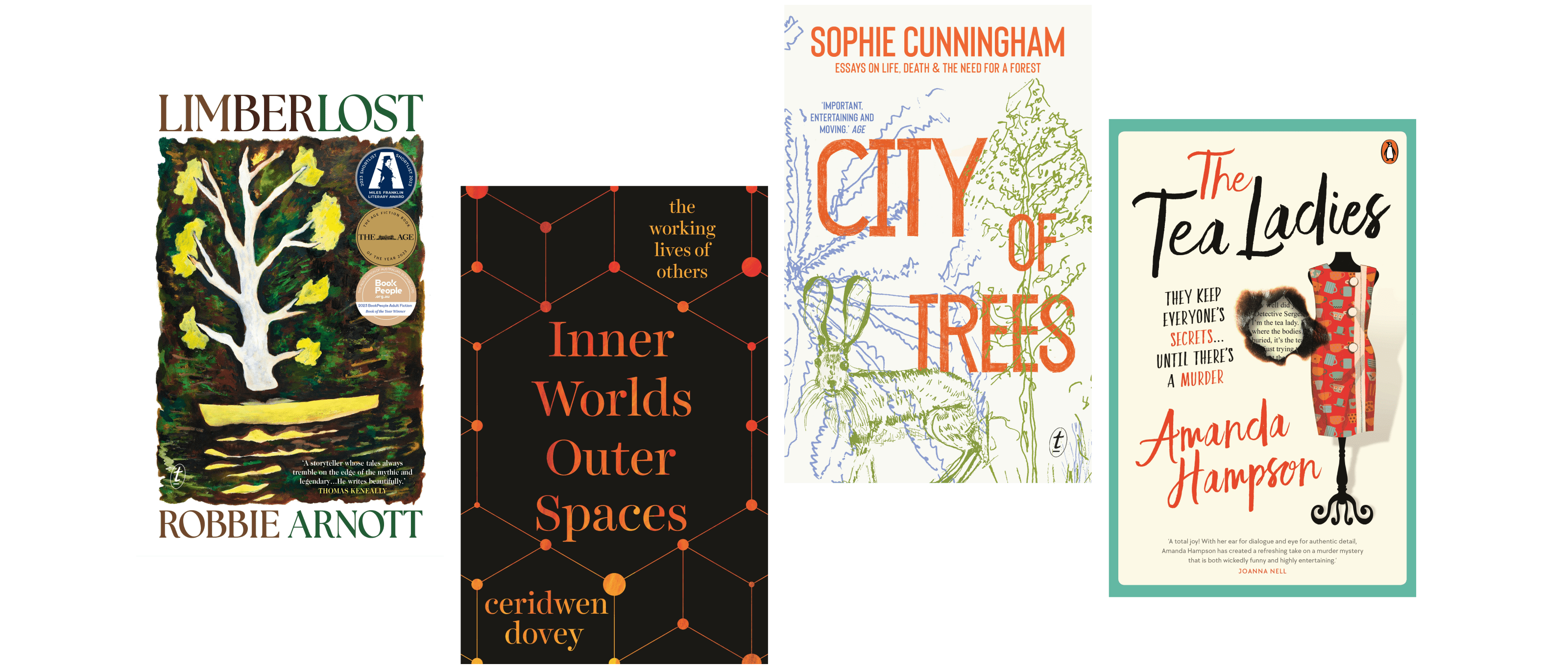
We’re always drawn to powerful Australian stories, and across the country, we’re lucky to have such an abundance of them to choose from. In search of some spring reading, we’ve picked out four Australian books—two fiction, two non-fiction—to add to your shelf this season.
In the spirit of variety, our selection features diverse subjects and styles. With their musings on nature, lyrical depictions of diverse landscapes and tales of innovation and resilience, these books all exemplify the qualities of great Australian storytelling.
Limberlost by Robbie Arnott
Limberlost is a fiction novel by Tasmanian writer, Robbie Arnott. A coming-of-age tale set against the romance and mystery of the bush, it takes us through the trials and tribulations of an apple farming family in northern Tasmania throughout WWII and is inspired by the tales of Arnott’s late grandfather, who grew up on an orchard in Tasmania’s Tamar Valley.
The story begins with Ned, a competent 15-year-old, living on the family orchard with his father and sister, his two brothers away at war. Ned’s story dances between past and present, carefully weaving anecdotes from his childhood and adult life. A constant in his life: nature as a source of both his comfort and turmoil.
Arnott’s lyrical prose is a love letter to the Tasmanian landscape, with descriptions so evocative, that you can practically smell the eucalypts and feel the strong winds of spring blowing off the pages. It’s a story about moving through life’s seasons, caring for and cultivating the land, and ultimately, our attachment to the people and places we call home.
Inner Worlds Outer Spaces by Ceridwen Dovey
What does it feel like to be passionate about your daily work? How do people find their way into fascinating, unusually fulfilling careers? How do they show up, day after day, even against the odds? These are just some of the questions at the heart of Inner Worlds Outer Spaces, a collection of profiles by Sydney-based social anthropologist and author Ceridwen Dovey.
In the season that signals change, Inner Worlds Outer Spaces is the ideal read. A fascinating look into the extraordinary working lives of others, Dovey meets a range of leading experts, from a space archaeologist to a master perfumer to a women’s rugby champion, all united by a shared drive to pursue their passion. This sharply written series of essays is as insightful as it is educational—the perfect book to pick up at this time of year, in contemplation of new beginnings and the possibilities that lie ahead.
City of Trees by Sophie Cunningham
Spring calls our attention to the trees; to their new growth and the scent of their blossoms, to their fresh and vivid colours, the shade of their shadows. Sophie Cunningham’s City of Trees does much the same, with beautifully written essays that explore the breadth and depth of our relationships with nature.
Published in 2019, these meandering essays are organised by particular trees of significance—beginning with a Coast Live Oak and ending with a Mountain Ash—and follow Cunningham as she encounters these trees in the places where she lives and travels. Each essay is accompanied by one of Cunningham’s illustrations (which also grace the book’s jacket) with simple, dreamlike sketches of the natural world.
From Melbourne to San Francisco and beyond, each tree to which she gives her attention becomes a springboard for thought-provoking reflections on life, love and loss. Storytelling for our time, City of Trees inspires wonder at the world around us with hope and understanding.
The Tea Ladies by Amanda Hampson
In Surry Hills in 1965, in the centre of Sydney’s rag trade, a group of tea ladies go about their business, swapping gossip and biscuits as they do their daily rounds. When a string of local crimes threatens their livelihoods, the tea ladies begin searching for clues, gathering intel from their local network and getting themselves into all sorts of (delightful) trouble.
The Tea Ladies is the new release by Melbourne-based author Amanda Hampson and is the reading equivalent of a spring clean. It is light, easy and comforting, much like the home-baked biscuits and cakes that feature frequently throughout the book, think Victorian sponges, ginger nuts, plum cakes and shortbread—which are always shared between friends around a pot of tea.
A sweet and cosy mystery you won’t want to put down (though you might need to, to get something sugary to eat) The Tea Ladies is a short and energising read. It's the perfect treat for spring, especially if you’re one to believe that everything’s made better over a cup of tea.

Seasonal reset
The return of warmer weather and lengthening days is a directive to reset your dressing routine. Out with the heavy layers and deep tones of winter; in with the lightweight, relaxed styles of spring.

Solid foundations – Australian made denim is a good idea all year round, but spring’s fluctuating temperature shift is a particularly good fit for these breathable, versatile pieces. Invest in a good pair of jeans and they’ll see you right through to summer.

Sporting style – The new season is a perfect backdrop for our bestselling rugby tops, designed for relaxed style and crafted for breathable, easy-to-layer comfort. Layer over T-shirts on fresh spring evenings and make sure to throw one in your pack for any spontaneous weekend adventures.

Light and breezy – The lengthening days and return of the sunshine is an invitation to refresh your look with airy spring neutrals. Pair lightweight shirts and cotton layers with denim and boots in deeper shades for effortless trans-seasonal style.

The spring road trip playlist
Our seasonal playlist has been curated for sun-drenched road trips, whether it’s a lazy coastal drive or a spontaneous adventure inland with friends. It’s a soundtrack for good times and connection with loved ones, laced with the possibility of adventure.
Hit the road. Hit play.











